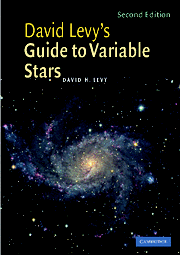Book contents
- Frontmatter
- Contents
- Foreword to the first edition
- Preface
- Acknowledgments
- Part I Getting to know the sky
- Part II Getting to know the variables
- 5 Meeting the family
- 6 Getting started with Cepheids
- 7 Algol, the demon of autumn
- 8 How to estimate a variable
- 9 Names and records
- 10 How your observations help us understand a variable star
- 11 Observing hints
- 12 Observing with CCDs
- 13 Stately and wonderful
- 14 Stars of challenge
- 15 Bright, easy, and interesting
- 16 Betelgeuse: easy and hard
- 17 Not too regular
- 18 Nova? What nova?
- 19 Supernovae
- 20 Clyde Tombaugh's star and the family of cataclysmic variables
- 21 A nova in reverse?
- 22 RU Lupi?
- 23 Orion, the star factory
- 24 Other variable things
- 25 The Sun
- Part III Suggested variables for observation throughout the year
- Part IV A miscellany
- Index
14 - Stars of challenge
from Part II - Getting to know the variables
Published online by Cambridge University Press: 05 August 2012
- Frontmatter
- Contents
- Foreword to the first edition
- Preface
- Acknowledgments
- Part I Getting to know the sky
- Part II Getting to know the variables
- 5 Meeting the family
- 6 Getting started with Cepheids
- 7 Algol, the demon of autumn
- 8 How to estimate a variable
- 9 Names and records
- 10 How your observations help us understand a variable star
- 11 Observing hints
- 12 Observing with CCDs
- 13 Stately and wonderful
- 14 Stars of challenge
- 15 Bright, easy, and interesting
- 16 Betelgeuse: easy and hard
- 17 Not too regular
- 18 Nova? What nova?
- 19 Supernovae
- 20 Clyde Tombaugh's star and the family of cataclysmic variables
- 21 A nova in reverse?
- 22 RU Lupi?
- 23 Orion, the star factory
- 24 Other variable things
- 25 The Sun
- Part III Suggested variables for observation throughout the year
- Part IV A miscellany
- Index
Summary
Two of the most famous Mira variables in the sky, R Leporis and Chi Cygni, are challenging, but for different reasons: R Leporis is unusually red, and Chi Cygni lies in a rich field of stars.
R Leporis
Until you've seen R Leporis at maximum, you haven't seen red. Here is a star whose redness offers us a new interpretation of color, a transcendent presence of vivid hue from a great distance.
In my early years of stargazing, I was guided by an old book by J. B. Sidgwick called Introducing Astronomy. During hundreds of observing sessions it taught me faithfully, pointing out the constellations one by one, as well as the inspiring contents of each. I especially remember the description of M42 as exciting to read about as the nebula was to look at. Then I'd turn the page for Lepus the Rabbit, just to see what glories were hidden from me in the little constellation that couldn't quite hop above the treetops of my southern horizon. It was Introducing Astronomy that taught me about R Leporis, Hind's Crimson Star, that shone in the sky like a drop of blood. As much as I longed to see this star, I expected I never would until either the trees fell down or I moved to a better site. Since neither prospect seemed very likely in the slowly-moving world of my youth, I relegated R Lep to a growing list of objects I would never see.
- Type
- Chapter
- Information
- David Levy's Guide to Variable Stars , pp. 77 - 82Publisher: Cambridge University PressPrint publication year: 2005

